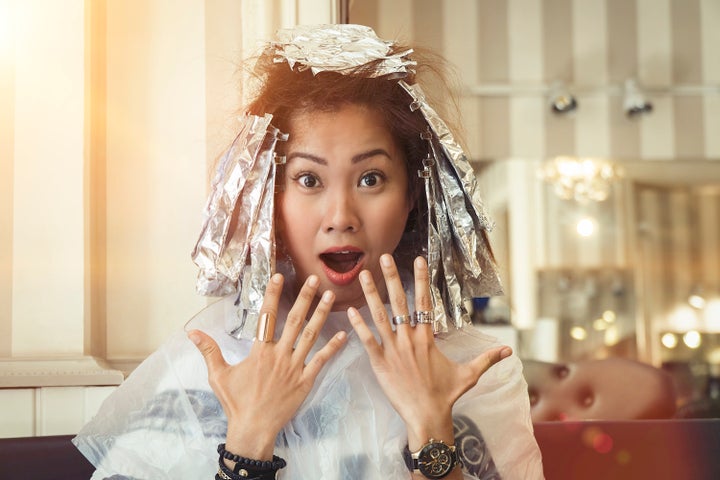
Working as a hairstylist is about much more than cutting and colouring folks’ hair. From teaching clients how to properly care for their manes to advising them on what would look best alongside their unique facial features, the profession also requires a bit of tact: it’s not easy to tell someone that they should consider changing up their hairstyle, for example.
And yet that’s a big part of the job. After years in the industry, stylists can take a single look at someone’s hair and be able to immediately diagnose what a customer is in need of — whether it be a different sort of shampoo, more frequent haircuts or perhaps a special scalp conditioner.
We reached out to a number of hairstylists to understand how exactly they know what they know — and how we can make sure our tresses are in tip-top shape before even heading to a salon. Here’s what they can tell simply by looking at your hair.
You Did Your Own Colour At Home
Given the price of a colouring session and how often they’re needed, it’s not unusual for people to touch up their hair at home between salon visits. But don’t think that your stylist won’t notice that you did your own colouring at home.
“I can immediately tell when someone has done their own colour at home and it didn’t go well,” said Paul Labrecque, the creative director and master stylist at Paul Labrecque Salon in New York City. “Most people who do their own hair colour do not know that a root touch-up is truly a root touch-up.”
“For example, I can always tell because by overlapping colour over and over again, roots can appear light brown while the hair ends are a very dark brown,” he continued. “On blondes, I can see bleeding marks in the scalp and even orange hues.”
How to solve colour-related hair issues: Labrecque suggested staying on track when trying to avoid any issues related to hair colouring. “I tell clients to keep up with a regular colour schedule that we determine together based on their budget, preferences and lifestyle,” he said. “It really makes a difference in hair health and appearance!”
You’re Pregnant
Yes, your hairdresser may be able to tell if you’re pregnant before you even take a test — it happened to Luke Ormsby, founder of Luke Ormsby Hair in London.
“I was giving highlights to a long-time client and I noticed the colour was lifting right away, so I knew she was pregnant before she knew herself,” he said, adding that dye becomes less absorbent when someone is expecting.
Ormsby isn’t the only one to make such a claim. A few months ago, stylist Samantha Penn took to TikTok to explain how she can tell if a client is expecting by simply looking at their hair.
“The way I can tell if you’re pregnant — your hair will either not be as curly if it’s normally curly [or] it won’t be as thick or thicker, so it will have a texture change,” she said in the video, also mentioning the presence of “new-growth hairs” as indicators of hormonal changes.
Penn also went into detail about being able to detect the gender of the baby based on her customer’s hair tendencies — but we’ll stay away from that one.

Your Scalp Is Too Dry
The majority of stylists we interviewed mentioned dry scalp conditions as one of the first things they notice when a client sits down in front of them.
“Often overlooked, but very important, is the condition of the scalp,” said Shu-Lan Cheung, the owner of Crafted salon in Chesterfield, United Kingdom. “Sometimes there are obvious signs. For example, flakes on shoulders or residue build-up.” Reported itchiness on the head may also signal a dry scalp.
Cheung explained that the scalp can be affected by a variety of factors, including seasonal changes that cause the skin to react to the weather differently. “In particular, sudden changes in temperature and humidity in the fall and spring months tend to leave the scalp either extremely dry or abnormally oily,” the expert noted.
How to treat a dry scalp: Regularly massage your scalp with one of the many massagers available on Amazon or an exfoliating scalp scrub product, and invest in an invigorating, moisturising shampoo and conditioner.
“The scalp scrub is the unsung hero of haircare,” Cheung said. “Prioritising a scalp scrub, particularly in the fall and spring, can help remove deep-seated dirt and dead skin cells. It’s perfect after a sunny holiday that might have caused a bit of sunburn, too: a perfect solution to get rid of dead scalp cells and reset your hair for long-term strength and shine.”
You’ve Been Spending Too Much Time In The Sun
Overexposure to heat from blow dryers or even hair straighteners is widely known to damage hair, but did you know that sitting in the sun for too long can also alter your locks’ appearance (and not in a good way)? That’s one more thing that stylists tend to tune into as soon as you walk in for your appointment.
“Sun damage looks like an over-saturation of blonde on hair ends, where highlights can start to appear more like a yellowy single-process job,” explained Labrecque, again touching upon the importance of proper care.
How to avoid sun damage: “You can best avoid [sun damage] by staying away from chlorine, covering your hair in the sun and by using excellent colour-hold products,” Labrecque advised. There are also several sunscreens specifically designed for hair.
Your Taste In Clothing
Believe it or not, your go-to hairstylist actually looks at you from the moment you walk into the salon to understand what sort of parameters you fit into and what styles you might claim as your own.
“We look at the style of clothing as soon as someone walks in,” revealed Ormsby. “We figure out what kinds of trends they follow as an indication to what style of hair they like and what they’re looking for.”
Keep in mind, though, that professionals don’t always get it right when it comes to your preferences. So if the haircut you want doesn’t necessarily match the goth look you happen to walk in with that day, be careful to specify your everyday style.
One thing is for certain, though: Hairstylists know much more than we may think about our lifestyle and beauty tendencies upon looking at us for even just a few seconds.